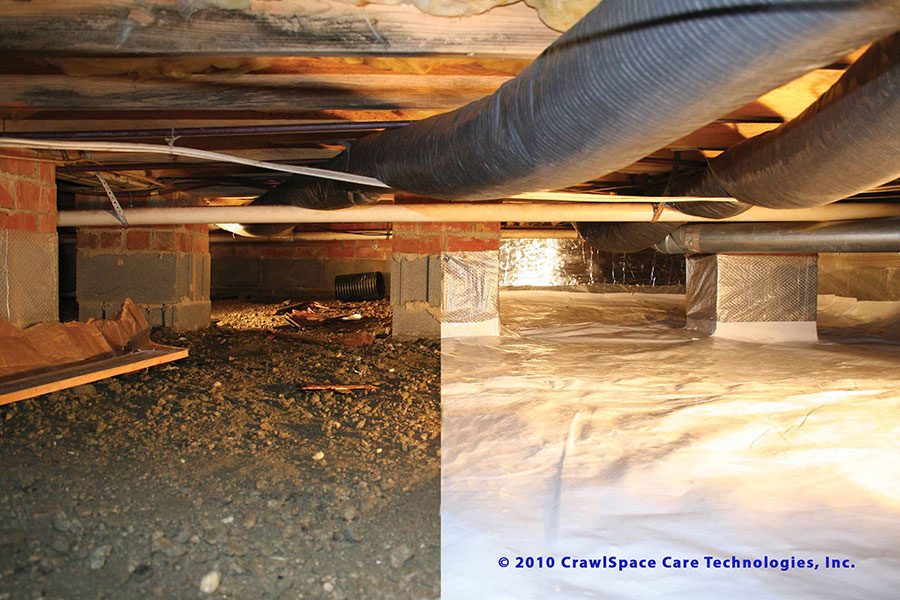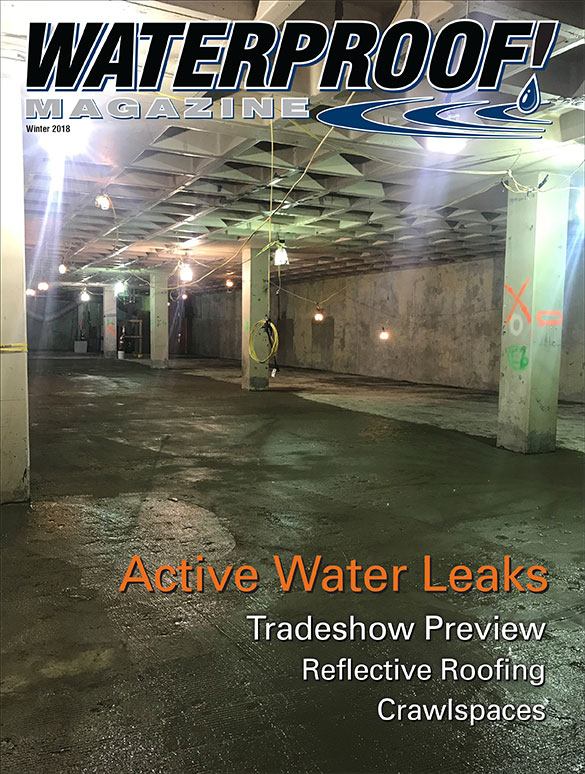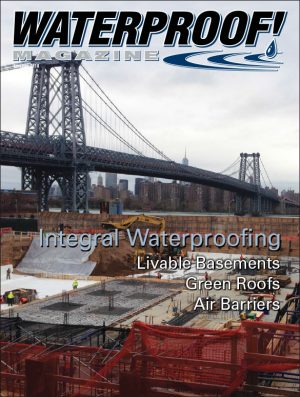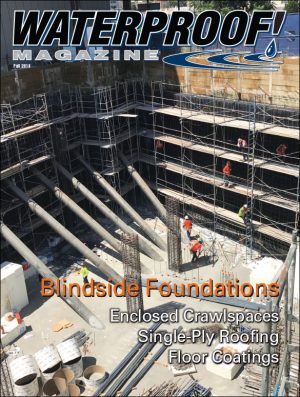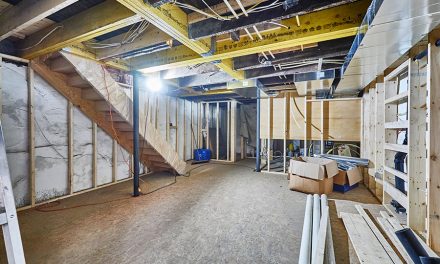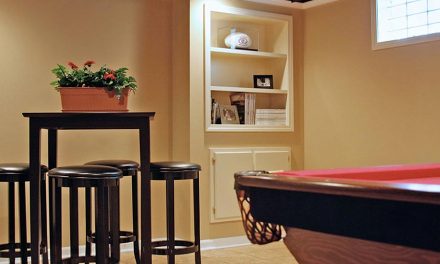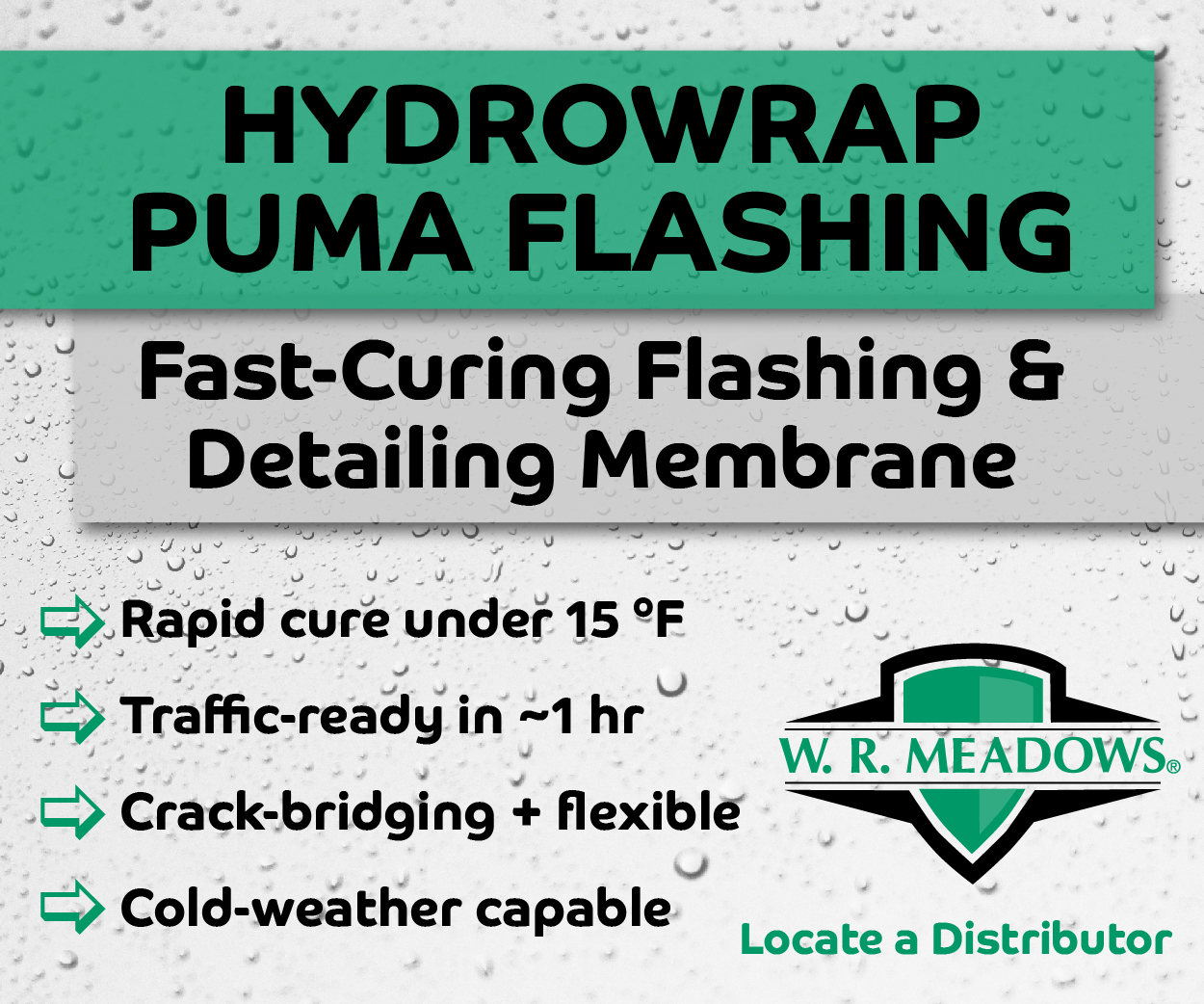Sealed crawlspaces offer cleaner air, safer storage, and improved energy efficiency
There’s a revolution happening underneath new homes. From encapsulated crawlspaces to internet-connected sump pumps technology is transforming how waterproofing contractors work. In many cases, the new solutions are faster, simpler, and more profitable than traditional methods.
Andre Lacroix is an executive at two different basement repair companies. One specializes in whole-house ventilation and dehumidification, the other in carbon fiber foundation repair. Over the years he’s helped many waterproofing contractors diversify and modernize their services. “They all say the same thing,” he says. “‘Wow, there is so much work that I have been passing up.’” He continues, “People just need to take off the blinders and open their eyes to the possibilities. Not only can it make you more money, but it can make you more marketable, and you will be able help more customers solve more of their problems.”
Carbon Fiber
Carbon fiber is a great example of a fairly recent technology that is transforming basement and crawlspace repair.
Bob Thompson, at Nationwide Reinforcing, says, “Homeowners appreciate a fast, non-invasive solution that gives them more living space and is nearly invisible when complete. The contractor eliminates the need for heavy equipment and crews hauling out buckets of concrete. Everything fits into the back of a pick-up truck, and most jobs require no more than two workers. The job is done in less than a day, so there’s less labor and significantly more profit in the job.”
Lacroix, who markets the StablWall line of carbon fiber repair products, agrees. “As a material, it’s slightly more expensive than steel beams, but factoring in the lower cost of labor, the lower cost of tools and faster completion times, you’ll be surprised how profitable it really is.”
In many ways, carbon fiber is a miracle material, but it does have weaknesses. It will not, for example, resolve structural failings. Any cracks or structural failings must be resolved before turning to carbon fiber.
Fortunately, crack repair is another area where technology is advancing quickly. According to the Basement Health Association, about 95% of residential basement cracks are non-structural, with water seepage as the only problem. In these cases, a semi-flexible polyurethane system is usually best.
Most waterproofers are familiar with epoxy- and polyurethane-based crack injection systems, but there are more than 500 different basement crack repair products on the market, with specialized products specifically designed for leak repair, hairline cracks, gushing water, voids, and other uses.
Encapsulated Crawlspaces
One of the biggest changes in the last decade is the move away from ventilated crawlspaces. Sealed crawlspaces have been proven to be drier, healthier, and far more energy-efficient than regular dirt-floored ones.
“The number one reason a homeowner seals a crawlspace is simple,” says Lou Cole, of Emecole Metro. “It is a wet, musty breeding ground for mold.”
With today’s tightly sealed homes, up to 40% of the air on the first floor of a home comes from the crawlspace, and it often contains unpleasant smells, mold spores and even radon gas, and musty odors.
From the high mountain deserts of Arizona to the muggy climate of Lousiana, virtually every crawlspace tested has benefitted from being sealed. The closed crawlspace systems tested in Baton Rouge, Louisiana reduced humidity from 80% to 60%. In the dry climate of Flagstaff, Arizona, closed crawlspaces lowered the humidity level to near 50% and saved nearly 20% on heating and cooling.

The untapped market for encapsulating crawlspaces is enormous. The job involves several steps, including closing off the air vents, sealing the dirt floor, and installing dehumidifiers, insulation, and sometimes a drainage system. In some instances, mold remediation and/or pest control is also needed.
Concrete slabs are sometimes used, but experts recommend using a flexible plastic membrane specifically designed for the task. Ron Greenbaum, owner of Nash Distribution, an Ohio-based waterproofing wholesaler, has sealed hundreds of basements over the years. “Concrete is a good option in new construction, but it’s often not a good choice for retrofit applications,” he says. The problem in retrofit jobs is that the low ceilings make it hard to finish the concrete right, and if the soil is contaminated, a liner will be needed anyway. And the water present in the concrete mix adds to the moisture problems, at least temporarily.
Liners avoid all those issues. Made by a number of companies, most are some kind of string-reinforced white polyethylene. Studies state that a 6-mil barrier is adequate to prevent moisture transfer, but if the client will be using the space for storage, a thicker (12- to 20- mil) liners is recommended for durability. Greenbaum says most of his clients in the upper Midwest plan on using the crawlspace, so he usually installs a thicker 20-mil barrier. “Whatever thickness you choose,” he says, “make sure it’s inorganic—so mold won’t grow—and puncture proof.”
Greenbaum says that in addition to moisture and mold, a crawlspace should also be protected from VOC’s like radon, benzene, contaminated groundwater, and dangerous soil vapors, which many membranes doesn’t block. His company is working to address this with a new liner material called WhiteCap VOC Block. He says, “It has all of the same moisture control benefits of standard liners plus an extra EVOH-infused layer that blocks harmful gases.”
Sump Pumps
If there’s liquid water in the crawlspace, a drainage system is mandatory, and must be installed before the liner. “Before you even can talk about closed or vented, you have to deal with the liquid water first,” says Greenbaum.
Frequently, this means putting a sump pump in the lowest area of the space.
Sump pump manufacturers have invested significantly in technology, offering better and more sophisticated sump pumps with back-up power, wireless alerts and alarms. Some are capable of texting or emailing the owners cell phone if they become disabled.
Most pump failure is actually due to the switch. Now, air switches and digital sensor switches canreplace the moving parts and floats that can jam or get hung up in traditional switch designs. The biggest advance of the past few years, though, is the so-called Internet of Things. Liberty Pumps’ NightEye system allows the sump pump to send alerts through the homeowner’s wireless network, providing alarms and performance information via text and email to up to four different address/phone numbers anywhere in the world. The system integrates with Liberty’s battery- and water-powered backup pump systems and is compatible with iOS and Android devices.

A few other sump pump makers offer similar systems. Wireless alert systems such as Liberty’s NightEye and Nash Distributing’s Gemini pumps come with a back-up data transmitter, so alerts can still be received during power outages when the WiFi router is down.
Increasingly battery back-up sump pumps are driven by lithium-ion batteries—the same technology that powers smartphones—offering greater power for longer periods than previously available.
Dehumidification
Healthy crawlspaces must also address water vapor issues. Sometimes a simple stand-alone dehumidifier will do the job, but if homeowner s are concerned about the smell of damp musty air, they should consider a dehumidifier that works as an air purifier as well.
“Dehumidifiers and air purifiers have flooded the market, and for a really good reason,” says John Bryant, president of the Basement Health Association (BHA). “By enclosing the crawlspace and making it part of the home, humidity, mold, mildew, and radon are eliminated from the living space.”
EZ Breathe markets a whole-house ventilation system that includes the crawlspace. “In a crawlspace, there are literally hundreds of toxins that a standard box system does not handle,” says Lacroix. “Instead of just sticking a box unit down there to deal with moisture, our system exhausts pollutants and moisture from the crawlspace at one end, and replaces it with air from upstairs at the opposite end.”
The system effectively reverses the stack effect by actively pushing conditioned air down into the crawlspace and works as a whole-house air exchange.
The company makes a larger version for homes with full basements in addition to the smaller version sized for crawlspaces.

Santa Fe, a leading manufacturer of free-standing dehumidifiers, combines top-quality, energy-efficient dehumidifiers with wireless monitoring technology. Called Santa Fe Sentry, the system ties sensors installed in the customer’s crawlspace or basement to a smart phone app that will allow contractors to monitor humidity, water leaks, temperature, and poor indoor air quality.
The system hit the market earlier this summer, and utilizes the customer’s WiFi signals. Unlike home-based monitors, Santa Fe Sentry eliminates unnecessary customer calls that result from humid weather conditions and allows the contractor to continuously monitor hundreds of locations from any Apple or Android smart phone. They can respond to issues as part of their normal service schedule or more quickly if the situation demands immediate attention.
The Future
“Waterproofers who only waterproof need to consider other profitable aspects of this industry,” says Bryant, at BHA. “The successful companies are out there finding new ideas and custom designing solutions to meet the customers’ needs,” he says.
Whether that involves carbon fiber, dehumidifiers, or internet-connected sump sumps, most contractors can profitably add state-of-the-art solutions to the services they offer.
Winter 2018 Back Issue
$4.95
Sealing Active Water Leaks
AVAILABLE AS DIGITAL DOWNLOAD ONLY
Description
Description
Additional Info
Additional information
| Magazine Format | Digital Download Magazine, Print Mailed Magazine |
|---|

